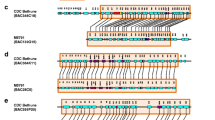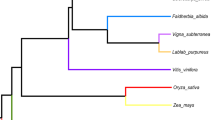Abstract
This paper reports the estimated gene copy number and restriction fragment length polymorphism (RFLP) map locations of five different desaturase cDNA clones from Brassica napus (oilseed rape). The desaturase enzymes encoded by four of these genes catalyze successive reactions that insert double bonds into lipid-linked fatty acid residues. Delta-12 (e2) and delta-15 (e3) desaturases are active in the endoplasmic reticulum, while omega-6 (p2) and omega-3 (p3) desaturases catalyze analogous desaturation reactions via a parallel pathway located in plastids. The fifth cDNA clone (b5) contains a desaturase-like domain bound to a cytochrome b5 segment. Estimates of gene copy number based on Southern blot analysis of 16 oilseed rape varieties and three different resynthesized Brassica napus lines indicated that e2 had 4–6 gene copies and e3, p2, p3 and b5 each had 6–8 gene copies per haploid genome. Estimates of the gene copy number for the two progenitor species, Brassica oleracea and Brassica rapa, supported the premise that all these genes were at least duplicated or triplicated in the two progenitor species before they combined to form B. napus. RFLP mapping results showed that the e2 probe detected 4 distinct loci, the e3 probe 6 loci and p2, p3 and b5 each detected 8 loci, with pairs of loci often mapping to homoeologous regions on 2 different linkage groups. The 28 mappable loci were distributed across 12 linkage groups of the B. napus map (Parkin et al. 1995) and were usually represented by single RFLP fragments. A collinear segment containing the e2 and p3 loci was positioned on B. napus linkage groups N1, N11, N3, N13, N5 and N15. This segment was collinear with a 30-cM region of Arabidopsis thaliana chromosome 3 that contains the homologous fad2 (e2) and fad7(p3) genes. This suggests that the desaturase multigene families arose as the result of duplication of large chromosome segments rather than duplication of individual genes.
Similar content being viewed by others
Author information
Authors and Affiliations
Additional information
Received: 14 August 1996 / Accepted: 18 October 1996
Rights and permissions
About this article
Cite this article
Scheffler, J., Sharpe, A., Schmidt, H. et al. Desaturase multigene families of Brassica napus arose through genome duplication. Theor Appl Genet 94, 583–591 (1997). https://doi.org/10.1007/s001220050454
Issue Date:
DOI: https://doi.org/10.1007/s001220050454




